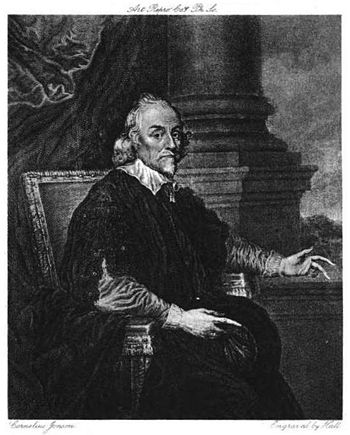William Harvey

William Harvey. From book of that name by D'Arcy Power, 1897
William Harvey (1578-1657), a late 16th early 17th century English physician, gifted humanity with one of the most important contributions to the progress of medical science. By introducing quantitative methods into anatomical and physiological investigations, Harvey discovered that the heart pumps blood through the body, and does so via a system of vessels such that the blood moves in a circle, from the heart through the arteries and back to the heart through the veins. Publishing those findings in his 1628 book, Exercitatio Anatomica de Motu Cordis et Sanguinis in Animalibus (Anatomical Exercises on the Motion of the Heart and Blood in Animals), usually referred to as De Motu Cordis,[1] Harvey made the following contributions in the history of medical science: [2]
- He solved a puzzle that unknowingly had eluded the western world's Galenic physicians up to his time — namely, the cardinal features of the map of the transport path of blood through the body — that blood circulates through the body from the heart and back to the heart;
- He reintroduced the concept of experimentation in scientific studies, earlier introduced by Galen but mostly ignored by medical researchers for nearly one and a half millennia;
- He introduced the first use of quantitative methods in medical research — by estimating the volume of blood pumped by the heart each day and showing the improbability that the amount of food consumed each day, if entirely converted to blood by the liver, as blood was supposedly formed, could account for that volume; and,
- Independently of of contemorary, Francis Bacon, he showed that reasoning by induction — generalizing from a collection of separate but related facts — could yield inferences about human physiology.
Brief sketch of Williams Harvey’s life
Born in 1578 (April 1, at Folkstone, Kent), the eldest of seven siblings, William Harvey entered the world shortly after Andreas Vesalius (1514-1564) had died, though his reputation based on his remarkably detailed and elegantly drawn illustrations revolutionizing the understanding of human anatomy had not. William Harvey had giant shoulders to stand on, and ultimately he saw further. He received his early education in the classics. Harvey's father, a landowner and successful merchant, could afford to send Harvey to the University of Cambridge, which he entered at age 16 years and received his B.A. at age 19 years. Harvey developed an interest in medicine and decided to go Italy, one of the major centers of intellectual activity in Europe at the time. He enrolled in the then renown University of Padua, studying medicine under Hieronymus Fabricius of Aquapendente, a noted anatomist in the Vesalian tradition, who had discovered the valves in the veins, a discovery which later contributed to Harvey's thinking that led to his discovery of the blood circulatory system. Harvey received his Doctor of Medicine degree in April, 1602, at age 24 years.
After Padua, Harvey returned to England and developed a practice in medicine, married, and became a Fellow of the College of Physicians in London. He also secured a position as physician at St. Bartholomew’s Hospital, one of London’s great hospitals, and there and in his private practice distinguished himself as a physician. In 1616, at age 38 years, the College of Physicians elected him their Professor of Anatomy and Surgery, and gave him the honor of the Lumleian Lectureship, in which he lectured on human anatomy and physiology twice per week before a distinguished audience that included his peers, which gave him great opportunity to organize his thinking and guide his research.
In 1618 he became physician extraordinary to the king (James I), and ministered to many eminent aristocrats, including Francis Bacon, for whom he had little regard as an intellectual. After Charles I succeeded the throne, in 1625, Harvey became Charles' physician, benefitting from the King’s patronage to pursue his medical investigations. When civil strife engulfed England, Harvey, now in his 60s retired to London to live with a brother, pursuing his experiments until he died in 1657, having lived nearly to the age of 80 years.[3] [4]
De Motu Cordis
....
References cited and notes
- ↑ Harvey W. (1628) On the Motion of the Heart and Blood in Animals. Translation: Robert Willis. The Internet Modern History Sourcebook. Paul Halsall, halsall@fordham.edu, Sourcebook Compiler.
- ↑ Nuland SB. (2008) Doctors: The History of Scientific Medicine Revealed Through Biography. The Teaching Company. (12 lectures, 30 minutes/lecture), Course No. 8128.
- ↑ Huxley TH. (1878) William Harvey and the Discovery of the Circulation of the Blood. (A free full-text PDF download) A Lecture delivered in the Free Trade Hall, November 2nd, 1878. From the Project Gutenberg Literary Archive Foundation [Etext #2939].
- ↑ William Harvey (1578-1657). Originally appearing in Volume V13, Page 47 of the 1911 Encyclopedia Britannica.